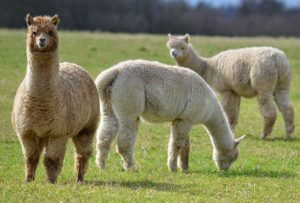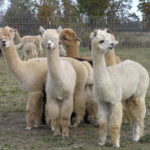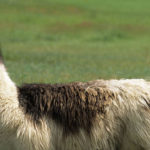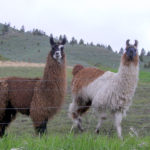Llamas
 The only large mammals domesticated by the ancient South American peoples, the Lama are the closest relatives of the camels, although they can not boast of the family logo – the hump. Like camels, lamas are intelligent and sociable animals, leading a herd life. They are completely harmless, but if they get angry, for example, after putting in an unbearable burden, they will immediately show their independent character. The dissatisfied lama will hiss, spit, jostle, but the most effective behavior in such cases is a strike strike.
The only large mammals domesticated by the ancient South American peoples, the Lama are the closest relatives of the camels, although they can not boast of the family logo – the hump. Like camels, lamas are intelligent and sociable animals, leading a herd life. They are completely harmless, but if they get angry, for example, after putting in an unbearable burden, they will immediately show their independent character. The dissatisfied lama will hiss, spit, jostle, but the most effective behavior in such cases is a strike strike.
You can not move the weary and irritated lama with a whip or a carrot, and the only way out of this situation is to transfer some of the load to another animal.
Since ancient times, more than five thousand years ago, the lamas have become indispensable helpers of the Indians of Central America in the transportation of heavy loads. Stamina and strong legs still help these powerful beasts of burden to pass along the narrow paths of mountain passes, carrying a luggage weighing about fifty kilograms.
To acquire such valuable helpers, the Indians of Peru domesticated the guanacos living on the high plateaus of the Andes. Two thousand years earlier, third members of the lamas-alpaca family (Latin Vicugna pacos) became domesticated. However, they were grown (and continue to this day) not for hard work, but for the sake of beautiful, warm and durable wool. Llamas and alpacas are one of the earliest domesticated animals in human history.
Resistance to thirst and unpretentious eating have made lamas an important part of the life of South American peoples. However, despite the fact that the lama is able to travel a distance of about thirty kilometers a day, it does not have the power of oxen, camels or horses, so it can not be used to transport adults or heavy wagons. And although her Inca masters invented the wheel, hardly at least one lama in history has carried something heavier than a normal wheelbarrow in a harness.
Like sheep and cattle, llamas chew gum and can spit in the face of the offender, as if to say: “Leave me alone!” However, this happens quite rarely, and in general, llamas are excellent companions for their owners. They are calm, friendly, easily trained, and even a child can manage them.
Female lamas, unlike males, enjoy special privileges – they do not have to carry weights, they are not milked, they do not participate in other household chores. Even at a time when the gods of the Incas demanded sacrifice, the females remained safe, and their main task was the continuation of the family.
The first young lama can produce in the light, reaching one year. The lama’s female breeds her offspring eleven and a half months, and the baby born after such a long period of time will be able to stand on its feet after an hour and a half. The mother does not lick her baby, because her tongue is too short and protrudes from her mouth no more than a half centimeter. Instead, the female gently rubs his nose and barely audibly snuffs, calming the baby.



























